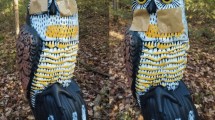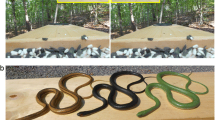Abstract
Inter-specific differences in the configuration of avian visual fields and degree of eye/head movements have been associated with foraging and anti-predator behaviors. Our goal was to study visual fields, eye movements, and head movements in two species of corvids: American crow (Corvus brachyrhynchos) and Western scrub jay (Aphelocoma californica). American crows had wider binocular overlap, longer vertical binocular fields, narrower blind areas, and higher amplitude of eye movement than Western scrub jays. American crows can converge their eyes and see their own bill tip, which may facilitate using different foraging techniques (e.g., pecking, probing) and manufacturing and handing rudimentary tools. Western scrub jays had a higher head movement rate than American crows while on the ground, and the opposite between-species difference was found when individuals were perching. Faster head movements may enhance the ability to scan the environment, which may be related to a higher perceived risk of predation of Western scrub jays when on the ground, and American crows when perching. The visual field configuration of these species appears influenced mostly by foraging techniques while their scaning behavior, by predation risk.





Similar content being viewed by others
References
Basil JA, Kamil AC, Balda RP, Fite KV (1996) Differences in hippocampal volume among food storing corvids. Brain Behav Evol 47:156–164
Bischoff H-J (1988) The visual field and visually guided behavior in the zebra finch (Taeniopygia guttata). J Comp Physiol A 163:329–337
Blackwell BF, Fernández-Juricic E, Seamans TW, Dolan T (2009) Avian visual system configuration and behavioural response to object approach. Anim Behav 77:673–684
Bluff LA, Weir AAS, Rutz C, Wimpenny JH, Kacelnik A (2007) Tool-related cognition in New Caledonian crows. Comp Cogn Behav Rev 2:1–25
Blumstein DT, Daniel JC (2007) Quantifying behavior the JWatcher way. Sinauer Associates Inc, Sunderland
Caffrey C (2000) Tool modification and use by an American Crow. Wilson Bull 112:283–284
Caffrey C (2001) Goal-directed use of objects by American Crows. Wilson Bull 13:114–115
Clayton NS, Dickinson A (1998) Episodic-like memory during cache recovery by scrub jays. Nature 395:272–274
Clayton NS, Dally JM, Emery NJ (2007) Social cognition by food-caching corvids. The western scrub-jay as a natural psychologist. Phil Trans R Soc B 362:507–522
Conner RN, Prather ID, Adkisson CS (1975) Common raven and starling reliance on sentinel common crows. Condor 77:517
Curry RL, Townsend Peterson A, Langen TA (2002) Western scrub-jay (Aphelocoma californica). In: Poole A (ed) The birds of North America online. Cornell Laboratory of Ornithology, Ithaca, New York. Available via The birds of North American Online database. http://bna.birds.cornell.edu/bna/species/712
Dagostino GM, Giovinazzo LE, Eaton SW (1981) The sentinel crow as an extension of parental care. Wilson Bull 93:394–395
Dawkins MS (2002) What are birds looking at? Head movements and eye use in chickens. Anim Behav 63:991–998
Dunlap K, Mowrer OH (1930) Head movements and eye functions of birds. J Comp Psych 11:99–112
Emery NJ, Clayton NS (2004) The mentality of crows: convergent evolution of intelligence in corvids and apes. Science 306:1903–1907
Emery NJ, Seed AM, von Bayern AMP, Clayton NS (2007) Cognitive adaptations of social bonding in birds. Phil Trans R Soc B 362:489–505
Fernández-Juricic E, Beauchamp G, Bastain B (2007) Group-size and distance-to-neighbour effects on feeding and vigilance in Brown-headed Cowbirds. Anim Behav 73:771–778
Fernández-Juricic E, Gall MD, Dolan T, Tisdale V, Martin GR (2008) The visual fields of two ground-foraging birds, House Finches and House Sparrows, allow for simultaneous foraging and anti-predator vigilance. Ibis 150:779–787
Friedman MB (1975) How birds use their eyes. In: Wright P, Caryl PG, Vowels D (eds) Neural and endocrine aspects of behavior in birds. Elsevier, Amsterdam, pp 181–204
Gall MD, Fernández-Juricic E (2009) Effects of physical and visual access to prey on patch selection and food search effort in a sit-and-wait predator, the Black Phoebe. Condor 111:150–158
Gall MD, Fernández-Juricic E (2010) Visual fields, eye movements, and scanning behavior of a sit-and-wait predator, the Black Phoebe (Sayornis nigricans). J Comp Physiol A 196:15–22
Gioanni H (1988) Stabilizing gaze reflexes in the pigeon (Columbia livia). 1. Horizontal and vertical optokinetic eye (Okn) and head (Ocr) reflexes. Exp Brain Res 69:567–582
Griesser M (2003) Nepotistic vigilance behavior in Siberian jay parents. Behav Ecol 14:246–250
Hunt GR (1996) Manufacture and use of hook-tools by New Caledonian crows. Nature 379:249–251
Iwaniuk AN, Heesy CP, Hall M, Wylie (2008) Relative wulst volume is correlated with orbit orientation and binocular visual field overlap in birds. J Comp Physiol A 194:267–282
Jones KA, Krebs JR, Whittingham MJ (2007) Vigilance in the third dimension: head movement not scan duration varies in response to different predator models. Anim Behav 74:1181–1187
Kamil AC, Balda RP, Olson DJ (1994) Performance of four seed-caching corvid species in the radial-arm maze analog. J Comp Psychol 108:385–393
Kral K (2003) Behavioural–analytical studies of the role of head movements in depth perception in insects, birds and mammals. Behav Process 64:1–12
Kulemeyer C, Asbahr K, Gunz P, Frahnert S, Bairlein F (2009) Functional morphology and integration of corvid skulls—a 3D geometric morphometric approach. Frontiers Zool 6:2
Land MF (1999a) Motion and vision: why animals move their eyes. J Comp Physiol A 185:341–352
Land MF (1999b) The roles of head movements in the search and capture strategy of a tern. J Comp Physiol A 184:265–272
Langen TA, Gibson RM (1998) Sampling and information. Behaviour 55:1245–1254
Lucas JR, Brodin A, de Kort SR, Clayton NS (2004) Does hippocampal size correlate with the degree of caching specialization? Proc R Soc Lond B 271:2423–2429
Maldonado PE, Maturana H, Varela FJ (1988) Frontal and lateral visual system in birds frontal and lateral gaze. Brain Behav Evol 32:57–62
Martin GR (1984) The visual fields of the tawny owl, Strix aluco. Vis Res 24:1739–1751
Martin GR (1986a) The eye of a passeriform bird, the European Starling Sturnus vulgaris: eye movement amplitude, visual fields and schematic optics. J Comp Physiol A 159:545–547
Martin GR (1986b) Total panoramic vision in the mallard duck, Anas platyrhynchos. Vis Res 26:1303–1306
Martin GR (1993) Producing the image. In: Zeigler HP, Bischof H-J (eds) Vision, brain, and behavior in birds. MIT, Cambridge, pp 5–24
Martin GR (1994) Visual fields in woodcocks Scolopax rusticola (Scolopacidae; Charadriiformes). J Comp Phys A 174:787–793
Martin GR (2007) Visual fields and their functions in birds. J Ornithol 148:S547–S562
Martin GR (2009) What is binocular vision for? A birds’ eye view. J Vision 9(14):1–19
Martin GR, Coetzee HC (2004) Visual fields in hornbills: precision-grasping and sunshades. Ibis 146:18–26
Martin GR, Katzir G (1994) Visual fields and eye movements in herons (Ardeidae). Brain Behav Evol 44:74–85
Martin GR, Katzir G (1995) Visual fields in ostriches. Nature 374:19–20
Martin GR, Prince PA (2001) Visual fields and foraging in Procellariiform seabirds: sensory aspects of dietary segregation. Brain Behav Evol 57:33–38
Martinez-Conde S, Macknik SL (2008) Fixational eye movements across vertebrates: comparative dynamics, physiology, and perception. J Vis 8:1–16
McFadden SA (1994) Binocular depth perception. In: Davies MNO, Green PR (eds) Perception and motor control in birds an ecological approach. Springer, Berlin, pp 54–73
Meyer DB (1977) The avian eye and its adaptations. In: Crescitelli F (ed) Handbook of sensory physiology. Springer, New York, pp 549–612
Moore JE, Switzer PV (1998) Preroosting aggregations in the American crow, Corvus brachyrhyncos. Can J Zool 76:508–512
Pravosudov VV, de Kort S (2006) Is the western scrub-jay (Aphelocoma californica) really an underdog among food-caching corvids when it comes to hippocampal volume and food caching propensity? Brain Behav Evol 67:1–9
Stouffer PC, Caccamise DF (1991) Roosting and diurnal movements of radio-tagged American crows. Wilson Bull 103:387–400
Stulp G, Emery NJ, Verhulst S, Clayton NS (2009) Western scrub-jays conceal auditory information when competitors can hear but cannot see. Biol Lett 5:583–585
Templeton JJ, Gonzalez DP (2004) Reverse lateralization of visual discriminative abilities in the European Starling. Anim Behav 67:783–788
Terhune EC (1977) Components of a visual stimulus used by scrub jays to discriminate a Batesian model. Am Nat 111:435–451
Tisdale V, Fernández-Juricic E (2009) Vigilance and predator detection vary between avian species with different visual acuity and coverage. Behav Ecol 20:936–945
Valcarcel A, Fernández-Juricic E (2009) Anti-predator strategies of house finches: are urban habitats safe spots from predators even when humans are around? Behav Ecol Sociobiol 63:673–685
Verbeek NA, Caffrey C (2002) American crow (Corvus brachyrhynchos). In: Poole A (ed) The birds of North America online. Cornell Laboratory of Ornithology, Ithaca, New York. Available via The birds of North American Online database. http://bna.birds.cornell.edu/bna/species/647
Voss J, Bischof HJ (2009) Eye movements of laterally eyed birds are not independent. J Exp Biol 212:1568–1575
Wallman J, Letelier JC (1993) Eye movements, head movements, and gaze stabilization in birds. In: Ziegler HP, Bischof HJ (eds) Vision, brain, and behavior in birds. MIT Press, Cambridge, pp 245–263
Wallman J, Pettigrew JD (1985) Conjugate and disjunctive saccades in two avian species with contrasting oculomotor strategies. J Neurosci 5:1418–1428
Weir AAS, Chappell J, Kacelnik A (2002) Shaping of hooks in New Caledonian crows. Science 297:981
Acknowledgments
We deeply thank Andrew Hubble (USDA-APHIS Wildlife Services) who helped capture some of the specimens used in this study. We thank John Aganon, Abel Hernandez, Gina Isitt, and Jennifer Scala for their efforts in gathering the behavioral data. Santos Bermejo, Tim Morgan, and Orange County Vector Control District provided essential assistance for the completion of the project. Jeff Lucas, Megan Gall, Ken Henry, Mark Nolen, Lauren Brierley, Patrice Baumhardt, and Jacquelyn Randolet provided useful comments on an earlier version of the draft. This study was funded by the National Science Foundation (DBI-0641550). The animal handling techniques used in this study were performed under approved protocols from Purdue University and California State University Long Beach Institutional Animal Care and Use Committees.
Author information
Authors and Affiliations
Corresponding author
Rights and permissions
About this article
Cite this article
Fernández-Juricic, E., O’Rourke, C. & Pitlik, T. Visual coverage and scanning behavior in two corvid species: American crow and Western scrub jay. J Comp Physiol A 196, 879–888 (2010). https://doi.org/10.1007/s00359-010-0570-0
Received:
Revised:
Accepted:
Published:
Issue Date:
DOI: https://doi.org/10.1007/s00359-010-0570-0




